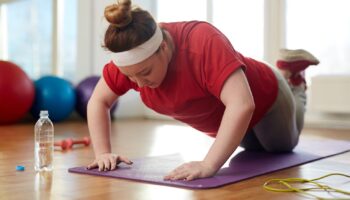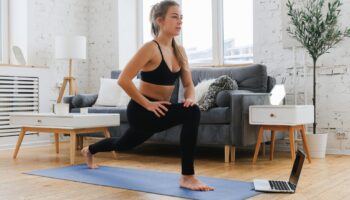Staying fit and active is crucial for maintaining overall health and well-being. With gym memberships, however, sometimes being costly or inaccessible, many people are looking for alternative ways to work out. Luckily, you can easily perform cardio exercises at home without needing any expensive equipment. In this article, we’ll explore the 10 best cardio exercises at home that will help you achieve a heart-pumping workout and keep you in great shape.
Best Cardio Exercises at Home
1. Jumping jacks
Jumping jacks are a classic choice for cardio exercises at home, delivering a heart-pumping workout that engages multiple muscle groups. As a high-impact, full-body aerobic exercise, jumping jacks can effectively elevate your heart rate and provide a solid cardiovascular workout.
In a study published in the Journal of Strength and Conditioning Research, jumping jacks were found to be an efficient method for improving cardiovascular fitness, particularly when performed as part of a high-intensity interval training (HIIT) routine.
To perform jumping jacks, follow these simple steps:
- Stand with your feet together and arms by your sides.
- Jump your feet apart and simultaneously raise your arms overhead, forming an “X” shape with your body.
- Jump your feet back together and lower your arms to the starting position.
- Repeat this movement at a steady pace for a set duration or number of repetitions.
For a more effective workout, try incorporating jumping jacks into a HIIT routine, which involves alternating between periods of high-intensity exercise and short rest intervals. This can maximize the cardiovascular benefits and help improve overall fitness levels.
2. Burpees
Burpees are an excellent choice for cardio exercises at home, providing a heart-pumping workout that targets multiple muscle groups simultaneously. As a compound exercise, burpees are known to effectively increase heart rate, improve cardiovascular fitness, and promote fat burning.
A study published in the Journal of Strength and Conditioning Research found that burpees, when performed as part of a high-intensity interval training (HIIT) program, can significantly improve aerobic capacity and anaerobic performance.
To perform a burpee, follow these steps:
- Stand with your feet shoulder-width apart and arms by your sides.
- Squat down, placing your hands on the floor in front of you.
- Jump your feet back into a plank position, maintaining a straight body line.
- Perform a push-up by lowering your chest towards the ground, keeping your elbows close to your body.
- Jump your feet back towards your hands, landing in a squat position.
- Explode upwards, jumping into the air with your arms extended overhead.
- Land softly, returning to the starting position, and immediately proceed to the next repetition.
Incorporating burpees into your cardio exercises at home can result in improved cardiovascular health, increased strength, and enhanced endurance. These dynamic, full-body exercises require no equipment, making them easily accessible for individuals at various fitness levels.
3. High knees
High knees are an effective option for cardio exercises at home, offering a heart-pumping workout that targets the lower body and core muscles. As an aerobic exercise, high knees can increase heart rate and improve cardiovascular fitness. A study published in the Journal of Exercise Physiology found that exercises like high knees, when performed as part of high-intensity interval training (HIIT), can lead to significant improvements in cardiorespiratory fitness.
To perform high knees, follow these steps:
- Stand with your feet hip-width apart and arms by your sides.
- Lift your right knee towards your chest, as high as possible, while simultaneously driving your left arm forward and your right arm back.
- Quickly switch legs, raising your left knee high and pumping your right arm forward.
- Continue alternating knees at a brisk pace, maintaining an upright posture and engaging your core.
For an even more effective workout, incorporate high knees into a HIIT routine, which involves alternating between short bursts of high-intensity exercise and brief recovery periods. This can maximize the cardiovascular benefits and lead to improved overall fitness.
4. Mountain climbers
Mountain climbers are a versatile and effective choice for cardio exercises at home, delivering a heart-pumping workout that engages the core, upper body, and lower body muscles. This dynamic exercise can increase heart rate and contribute to improved cardiovascular fitness.
Research published in the Journal of Sports Science and Medicine supports the benefits of mountain climbers, suggesting that they can be an essential part of a high-intensity interval training (HIIT) routine for enhancing overall aerobic capacity.
To perform mountain climbers, follow these steps:
- Begin in a plank position with your arms straight, wrists below your shoulders, and your body forming a straight line from head to heels.
- Engage your core and lift your right knee toward your chest.
- Quickly return your right foot to the starting position while simultaneously driving your left knee toward your chest.
- Continue alternating legs at a fast pace, keeping your core engaged and maintaining a stable upper body.
5. Jump rope
Jump rope is a highly effective option for cardio exercises at home, offering a heart-pumping workout that improves cardiovascular fitness, coordination, and agility. Research published in the Research Quarterly for Exercise and Sport demonstrates that jumping rope can significantly increase heart rate and burn calories, making it an efficient choice for cardiovascular workouts.
To perform jump rope exercises, follow these steps:
- Hold the jump rope handles with a comfortable grip, keeping your elbows close to your body.
- Position the rope behind your heels, with your feet close together.
- Rotate your wrists and forearms to initiate the swing of the rope, allowing it to pass over your head.
- As the rope approaches your feet, jump just high enough to clear the rope, landing softly on the balls of your feet.
- Maintain a steady pace and rhythm while jumping, keeping your core engaged and upper body relaxed.
Jumping rope can be easily incorporated into cardio exercises at home, and its intensity can be adjusted to accommodate various fitness levels. Experiment with different jump rope techniques, such as single-leg jumps, double unders, and crisscross patterns, to keep your workouts challenging and engaging.
6. Butt kicks
Butt kicks are a dynamic and convenient option for cardio exercises at home, offering a heart-pumping workout that focuses on the hamstrings and glutes. This exercise can increase heart rate and improve cardiovascular fitness, making it an ideal addition to any home workout routine.
Research published in the Journal of Exercise Physiology supports the benefits of exercises like butt kicks when performed as part of high-intensity interval training (HIIT) programs, resulting in significant improvements in cardiorespiratory fitness.
To perform butt kicks, follow these steps:
- Stand with your feet hip-width apart and arms by your sides.
- Begin jogging in place, lifting your heels toward your glutes with each step.
- Keep your upper body relaxed and maintain a slight forward lean to engage your core and maintain balance.
- Continue at a brisk pace for a set duration or number of repetitions, ensuring your heel makes contact with your glute on each step.
7. Skater jumps
Skater jumps are an engaging and effective option for cardio exercises at home, providing a heart-pumping workout that targets the lower body, particularly the glutes, quads, and hamstrings. This lateral movement can help improve cardiovascular fitness, coordination, and balance.
A study published in the Journal of Human Kinetics highlights the benefits of multi-directional exercises, like skater jumps, in promoting overall athletic performance and functional fitness.
To perform skater jumps, follow these steps:
- Stand with your feet shoulder-width apart and bend your knees slightly.
- Push off your right foot and jump laterally to the left, landing softly on your left foot while swinging your right foot behind your left leg.
- Maintain your balance on your left foot, and then push off to jump laterally to the right, landing on your right foot and swinging your left foot behind your right leg.
- Continue alternating sides at a brisk pace, engaging your core and maintaining a slight bend in your knees throughout the movement.
8. Speed skaters
Speed skaters are a powerful and dynamic option for cardio exercises at home, offering a heart-pumping workout that targets the lower body muscles, including the quads, hamstrings, and glutes. As a high-intensity exercise, speed skaters can increase heart rate, burn calories, and improve cardiovascular fitness.
Research published in the International Journal of Exercise Science suggests that multi-directional exercises like speed skaters can lead to significant improvements in agility, balance, and overall functional fitness.
To perform speed skaters, follow these steps:
- Begin standing with your feet shoulder-width apart and arms by your sides.
- Shift your weight to your left leg, and then jump laterally to the right, landing on your right foot and sweeping your left foot behind your right leg.
- Push off your right foot and jump laterally to the left, landing on your left foot and sweeping your right foot behind your left leg.
- Continue alternating sides at a brisk pace, keeping your core engaged and maintaining a slight bend in your knees throughout the movement.
9. Step-ups
Step-ups are a simple yet effective option for cardio exercises at home, delivering a heart-pumping workout that targets the lower body muscles, particularly the quads, hamstrings, and glutes. As a weight-bearing exercise, step-ups can increase heart rate, promote fat burning, and improve cardiovascular fitness.
Research published in the Journal of Strength and Conditioning Research suggests that step-ups, when performed with moderate to high intensity, can lead to significant improvements in lower body strength and power.
To perform step-ups, follow these steps:
- Stand in front of a sturdy step or bench with your feet hip-width apart.
- Place your right foot onto the step, keeping your heel flat and your toes pointed forward.
- Push through your right heel to raise your body onto the step, straightening your right leg.
- Step your left foot up onto the step, standing tall with both feet on the step.
- Step down with your left foot first, followed by your right foot, returning to the starting position.
- Repeat the exercise for a set number of repetitions or duration before switching legs.
10. Dancing
Dancing is a fun and engaging option for cardio exercises at home, providing a heart-pumping workout that can increase cardiovascular fitness, burn calories, and improve coordination and balance.
Research published in the Journal of Sports Sciences suggests that dancing can be an effective form of moderate-intensity aerobic exercise, leading to improvements in cardiovascular health and overall physical fitness.
To perform dancing as a cardio exercise at home, follow these steps:
- Choose your favorite style of music and create a playlist.
- Clear a space in your home with enough room to move freely.
- Begin by warming up with some simple stretches and light movements to prepare your body.
- Start dancing, incorporating a variety of movements such as jumping, twisting, and shaking your hips.
- Continue dancing for a set duration, gradually increasing the intensity and pace of your movements as your fitness level improves.
Incorporating dancing into your cardio exercises at home can be an enjoyable and effective way to stay active and improve cardiovascular fitness. With no equipment required and a wide range of dance styles to choose from, dancing offers a low-impact and engaging way to get your heart pumping and improve your overall health.
With these 10 heart-pumping exercises, you can easily boost your cardiovascular fitness, strengthen your muscles, and enjoy a great workout in the comfort of your own home. Remember to warm up before starting any exercise routine and modify these exercises as needed to suit your fitness level and abilities. Always listen to your body and stop if you experience pain or discomfort. Happy exercising!










